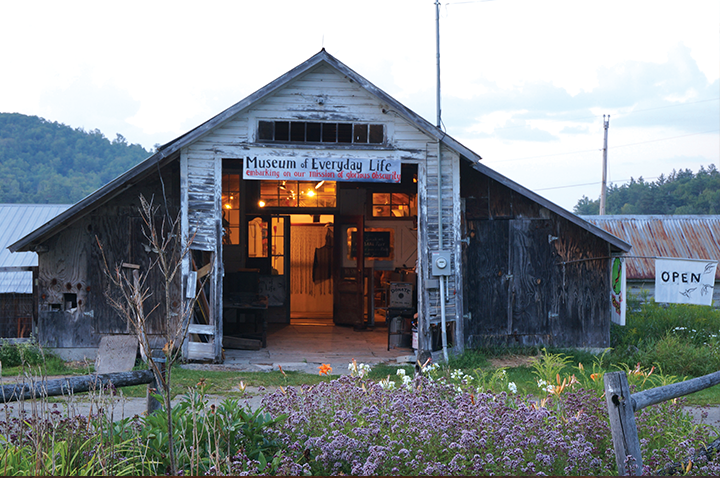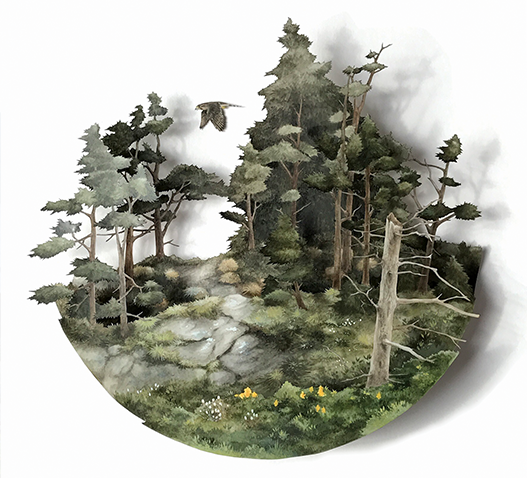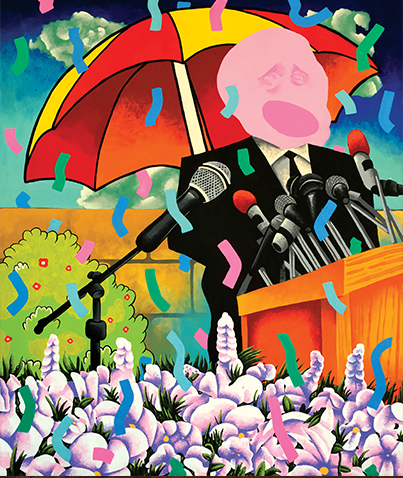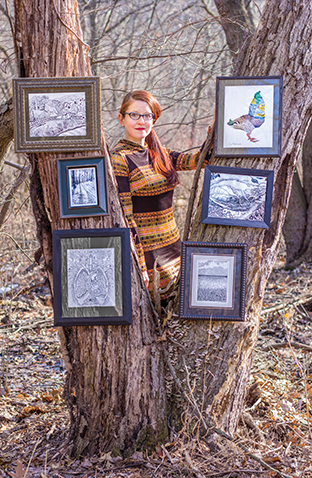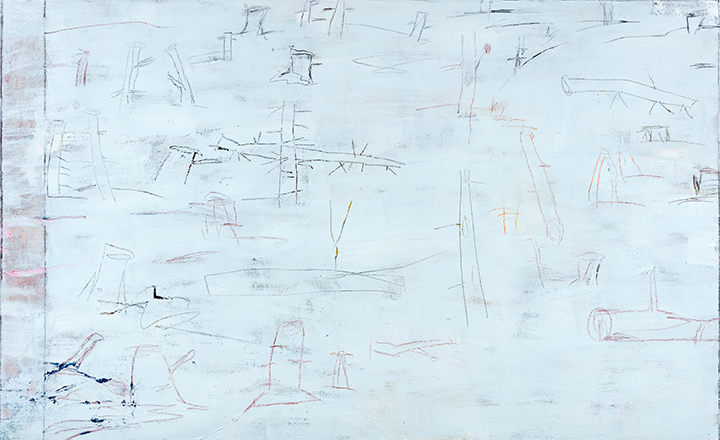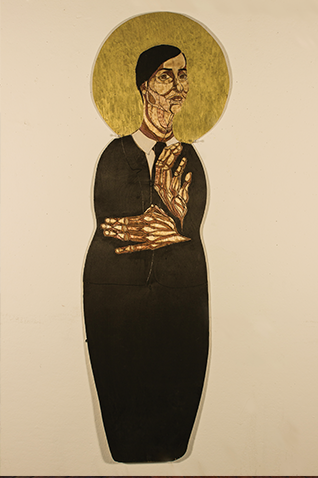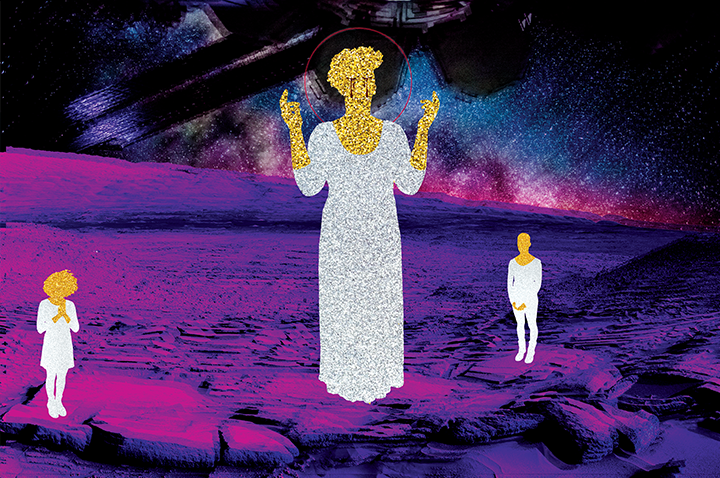10 Emerging New England Artists
For artists today, there are many avenues to success. For emerging artists, this undertaking can at times appear formidable. And, for all artists, developing and sustaining that path requires innovation, courage and resolution. Here, we highlight 10 of the most exciting emerging artists from New England who are determinedly forging their own way. Working in an array of mediums, these artists have distinct practices and visual languages. They range from students recently graduated from college, to a self-taught creative, to a painter in her 60s who, after many years away from a studio practice, has recommitted to making. They may have been working consistently on a body (or bodies) of work for a period of time but have had little or no gallery representation. Whatever their age or background, what they share is that they are helping to shape the future of contemporary art.
To find these emerging artists, Art New England reached out to a nominator in each state—individuals who view a lot of new art yet also understand gallery and museum systems and the pressures of making choices between artists. We extend our thanks to: David Grozinsky, admissions manager, Vermont Studio Center, Johnson, VT; Helen Kauder, executive director, Artspace, New Haven, CT; Corwin Levi, curator and visual artist, Harrisville, NH; Denise Markonish, curator, MASS MoCA, North Adams, MA; Suzette McAvoy, executive director/chief curator, Center for Maine Contemporary Art, Rockland, ME; and Shey Rivera Ríos, artistic director, AS220, Providence, RI.
Katie Bullock, Throwing the End Inwards (installation view), 2016.
Katie Bullock
Providence, RI
“[Bullock] beautifully blends wonder, the sublime, the poetic, and vulnerable…(She) looks at the world deeply, as if she is a living, breathing microscope. She finds moments in the everyday that we often look past, and she quietly calls our attention to them. Her work, while intimate and minimal, opens the door to the whole world, allowing you to see everything with eyes wide open,” says Denise Markonish, curator, MASS MoCA.
For the past decade, Katie Bullock has been cataloging moments in simple notes and using graphite to make small rubbings from various texts. Her notes and collection of incongruent texts may appear disparate, yet they are Bullock’s continued attempt to comprehend the world around her. These notes were used in her recent exhibition Life in Velocity: Gradients—a site-specific installation that unfolded over more than a month—in Outside, an alternative gallery, in North Adams, MA. She displayed her small pen and pencil drawings, as well as simple words on paper, on L-shaped plinths, making the room resemble a quiet reading room. Visitors dialogued with Bullock and interacted with the work through physical rearrangement of the installation.
“[Life in Velocity] was exciting and challenging. I was able to reconcile many of the ideas I had been working with, and it totally worked as a catalyst to move me forward with my work,” says Bullock. From this exhibition, she decided to incorporate her studio practice into her everyday life. She now carries her work in small notebooks—gathering objects, making notes and drawings. This decision broadened what the artwork was about and allowed for new conversations. Bullock, age 27, graduated from RISD with an MFA in Glass in 2016. Since then, she has embraced making art and building an art career as a “wondrous yet unfathomable adventure.”
The entrance to Clare Dolan’s Museum of Everyday Life. Photograph Gabriel Levine.
Clare Dolan
Glover, VT
“Clare’s work is very intense. Viewing it changes you like having a profound dream. It involves truth and fantasy, the mundane and the profound. Her work is so tantalizing that you want to eagerly enter a realm of deep play. From that, a whole new world opens up. The story she tells is so compelling, you want to go along with her to see where it might lead,” says David Grozinsky, admissions manager, Vermont Studio Center.
Clare Dolan’s Museum of Everyday Life in her barn in Glover, VT, is, as she describes it, “…a heroic, slow-motion cataloguing of the quotidian—a detailed, theatrical expression of gratitude and love for the miniscule and unglamorous experience of daily life in all its forms.” Her 2014–2015 exhibition, for example, Toothbrush from Twig to Bristle in All Its Expedient Beauty, explored the history of the toothbrush through displays accompanied by documentation and photographs.
“Because I am working outside of the mainstream art world, I sometimes question what being an artist means,” Dolan, age “39+”, says. “I find the answer for myself in understanding myself as a creature that, like all creatures, engages in an activity that has a purpose in and of itself.” Dolan’s dogged determination to discover and experience is at the very heart of her work. By fusing her art with her life and exhibiting it in this way, she raises questions about the mundane and the profound—from politics to power relations, from natural disasters to dressing, from going to work to buying groceries. After a visit to her museum, you have a new appreciation for the overlooked tools of our daily existence.
The 2018 Museum of Everyday Life exhibition opens May 27.
Isaac Jaegerman, Cut Paper Doubled Over, 2017, cut paper against black background, approx. 28 x 37 x 7″. Courtesy of the artist.
Isaac Jaegerman
Portland, ME
“[There is] an enormous refinement and honing of his ideas in the work of the past two years. I am impressed by how well-developed and consistent Isaac’s aesthetic vision and skill level is for someone just starting out,” says Suzette McAvoy, executive director/chief curator, Center for Maine Contemporary Art.
Recent Bowdoin College graduate Isaac Jaegerman’s cut-paper work explores the physical, theoretical and philosophical abstractions present in nature. “Critical thinking is important to the progression of the work. I always write about the work I have made. What I discover about the work when I review it often ends up being a jumping-off point for the next work. There is a summarization and progression,” says Jaegerman. This intellectualization of process is evident in the work itself—his delicate, fractal-like designs appear to spin off into space, yet they are still and contained. He places his ethereal work against a dark background—almost a black hole—amplifying the tension between the positive and negative, the advancing and retreating.
The 24-year-old recently moved into a nook within a larger studio in Brunswick, ME. This move has allowed him to create multiple works simultaneously and begin developing a series of large-scale paintings. The space provides not only the capacity to create, but also colleagues at all stages in their careers. “It’s exciting; we feed off each other,” he says. A former Bowdoin professor offered Jaegerman the studio with the condition, “You can use the space if you use the space.” Art-making has always been a priority for Jaegerman and his dedication to his practice is enriched by working in his studio community.
Jaegerman has a print included in the Maine-Aomori Printmaking Society (MAPS) exchange, which is showing in Aomori, Japan, and in Portland, ME, later this year.
Zehra Khan, Last Cigarette, 2010, acrylic on canvas, paper and self, 6 x 10 x 3′. Courtesy of the artist.
Zehra Khan
Provincetown, MA
“What keeps me intrigued about Zehra’s work is that it eschews any naturalism. Constructing the characters and the environments they inhabit is labor-intensive and process-driven yet it ultimately gets to something very simple yet also very beautiful and intriguing. In Zehra’s work there appears to be a struggle that is engaged fully, and that engagement has a strength that convinces one to go along with her—one wants to believe even when one doesn’t know what one is believing,” says David Grozinsky, admissions manager, Vermont Studio Center.
Zehra Khan’s multidisciplinary and performance-based work reflects a commitment to uncertainty and finding pleasure within that uncertainty. In Last Cigarette (2010), anthropomorphic characters inhabit fragile cartoonlike worlds reminiscent of pop-art constructions by Red Grooms. The performances are photographed, arranged and posted online in a way that resembles comic strips.
In Khan’s most recent work, Oh Shit Quilt, she creates double-sided brightly colored patchworks made from paper, acrylic, staples and even long johns that mimic a fabric quilt. Because of the materials, construction and title, however, she questions the concept of comfort.
The 35-year-old Pakistani-American has lived in Indonesia, France, Switzerland and the U.S. Because of this, Khan enters uncertain terrain with the passion of an explorer. After graduating with an MFA from Massachusetts College of Art and Design in 2009, she lived and worked in Provincetown, MA. In January, she assisted artist Cindy Kleine on a projection-installation in Brooklyn, NY, and in February, she was a resident at the Vermont Studio Center. From there, she says, “I have no idea where I’ll go… I really love to attack life without a great deal of planning.”
Allison Kiphuth, Arrival, Exodus, 2017, watercolor, ink and encaustic on layers of hand-cut paper, 8 ¾ x 9 x 1″. Courtesy of the artist.
Allison Kiphuth
Portsmouth, NH
“Kiphuth [shows a] technical mastery and creativity that elevates whatever scene or topic she addresses into a unique and special experience for the viewer,” says Corwin Levi, curator and visual artist.
Allison Kiphuth’s miniature dioramas and watercolor paintings are finely rendered landscapes. Her small, delicate, naturalistic paintings—sometimes cut and made into three-dimensional scenes embedded within antique boxes—absorb the viewer.
“I have to find a way to have the work stay true to what it is, stay true to the small works I am engaged in making, and yet still move towards a goal I have of a large installation that fully immerses the viewer, like a walk in the woods,” says Kiphuth. The 29-year-old experimented with installation in Bioconstellation, a recent exhibition at Nahcotta gallery in Portsmouth, NH, in which she hung hundreds of separate images of natural objects on the walls. The arrangement established connections while suggesting disparities between the subjects.
Kiphuth’s recent decision to move her studio into her living room where she is surrounded by the objects that she collects—feathers and pine cones, for example—reflects her desire to create an immersive environment. “For some people this wouldn’t work,” she says, “but it works for me because I can be surrounded by my work all day in the solitude that I now understand nourishes my creative process.”
In May 2018, Kiphuth will have a solo exhibition, Allemansrätte, at Nahcotta gallery.
Eben Kling, Flesh Cartoon (Man with Microphones), 2017, acrylic and Flashe on canvas,
32 x 38″. Courtesy of the artist.
Eben Kling
Branford, CT
“[Kling’s work] embraces the color, style and humor of Chicago imagists Peter Saul and Jim Nutt, the New York School painters Willem de Kooning and Philip Guston, and outsider artist/cartoonist R. Crumb,” says Helen Kauder, executive director, Artspace, New Haven.
Eben Kling’s work, whether sculpture, installation or painting, explodes with acid colors and jumbled, torn, confused and dislocated entities—hands, cars, bodies, road signs and posters. The garish forms, graphic quality and loneliness of the figures in his semi-familiar landscapes are eerie yet compelling and evoke Alan Davie, Andy Warhol and Edward Hopper. His inspiration, he says, comes from what he sees happening every day and from those around him, particularly his students and colleagues.
“Kling approaches painting as an arena of interchangeable high and low art forms,” says Sarah Fritchey, curator at Artspace, New Haven. “At its basic level, his topsy-turvy landscapes question the ideology of a universal experience or collective consciousness. Kling unearths a menagerie of tragic-comedic characters who are entangled in acts of debauchery and negligence. [His] paintings unfold like half-conscious psychodramas. They speak to our crises of subjectivity and embodiment. Are we awake? In a daydream? In trouble? Or just partially subsumed in a virtual reality of our own making?”
These questions and the discourse he engages in are echoed in his belief that “If you are making art that is being shared, then you have a responsibility to tell people about it, to be able to explain it,” says the 31-year-old Kling.
Kling received his MFA from UMass Amherst in 2015.
Zoe Matthiessen and her gallery in the woods at East Rock Park. Photo: Tangible Planet
Zoe Matthiessen
New Haven, CT
“[Matthiessen’s] finely observed landscapes and portraits are both poignant and witty. She has captured the political moment and, like the best illustrators, is inspired by everyday news. She has become known for her studio without walls, in which she hides prints in public parks and invites people who find them to take them home,” says Helen Kauder, executive director, Artspace, New Haven.
“Up until this last year, my artistic response to the chaos in the world has mainly been to hide in the woods and draw to escape,” says Zoe Matthiessen, a self-taught illustrator. “I’ve found myself finally able to rant with my dip pen when rattled by the day’s news, particularly when it comes to environmental issues.” In 2017, Matthiessen funneled her rants into her weekly series for the New Haven Independent, Ecocide—pen and ink drawings and paintings of animals and other subjects. One of those strips, Why-Why? featured a wide-eyed, uncomprehending owl in front of a deforested land.
Her other series for the Independent, Picture This, was a local scavenger hunt that encouraged people to get out into the woods. Matthiessen inked or painted a New Haven location and published it in the newspaper. Readers who recognized the location, took a picture of it, emailed it to Matthiessen and, in return, received a print of the cartoon.
Today, the 46-year-old Matthiessen’s goal is to get her environmental work seen by the biggest audience possible. One recent piece, Brothers from Another Mother, a watercolor depicting a swan with plastic baby bottles trailing in the water behind her, appeared in The Nation. And two more recent works, Half-Mast/Half-Assed and Taxonomy appeared in the American Bystander.
Matthiessen was recently invited to be in an exhibition at the Society of Illustrators.
Jody Payne, Blue Wood B, 2017, oil, graphite and conté crayon on canvas, 34 ½ x 56″. Courtesy of the artist.
Jody Payne
CUSHING, ME
“There is a terrific immediacy and freshness to [Payne’s] take on the Maine landscape,” says Suzette McAvoy, executive director/chief curator, Center for Maine Contemporary Art.
Payne earned a BFA in 1979 from the Corcoran School of Art in Washington, D.C., but for many years only painted occasionally. When Payne turned 60 last year, she laid down a gauntlet for herself. She quit her job as a horticulturalist, relocated to Maine, built a studio and told everyone she was painting. “I made myself sit at home and didn’t allow myself to do anything else but go to my studio,” she says. “When I picked up my paintbrush again, the stroke I started was like the same stroke I’d left years before; it was as if no time had passed.”
This sense of purpose is reflected in Payne’s process. The doodles and words she begins with “come from an ephemeral place and then grow. If I don’t feed them with my attention then they will go away,” she says. Ephemerality, and a feeling of being lost are realized in the quiet subtle tones and gentle marks that question the gap between abstraction and reality. There is a quiet rhythmic quality to the marks and spaces within paintings such as Blue Wood B, 2017. This work in oil, graphite and conté crayon has scratched trees that slowly emerge from the softly hued, dusky gray-blue background.
Payne commits to her art career the way she commits to a painting. “It’s like when you’re walking out in water and you are deep enough that your feet lift off the bottom, there is a moment when you realize you are not fully in control, but to fully explore this new experience you have to let yourself get lost within it.”
Andrea Pérez Bessin, Sincretismo: Sancta, 2017, pyrography and ink on plywood, 47 x 13″.
Photograph by Keane Patiño Right.
Andrea Pérez Bessin
Newport, RI
“[Pérez Bessin’s] work pays tribute to the Afro-indigenous roots of the Caribbean. It reminds us that our struggles, and what we fight for today, are the continuation of those of our ancestors. Her work depicts magic, spirituality, the worker, the racial legacy of our mixed Caribbean heritage. [Her] work is timely in the national dialogue around the humanitarian crisis in Puerto Rico. It brings hope and strength, while connecting us with our legacy as warriors and people of the land,” says Shey Rivera Ríos, artistic director, AS220.
Puerto Rican native Andrea Pérez Bessin is a printmaker and installation artist. Her large, bold black-and-white graphic woodcuts of female deities wearing ties and suits surrounded by plants are finished pieces in themselves, yet, she often combines them with smaller milagros, and other objects, to create installations that explore gender, religion and sexuality.
The 29-year-old Pérez Bessin’s work is an “exploration of the distillation of the systems of worship and ornamentation within worship.” Her most recent work involves the word patria, which is a feminine gender noun, yet it refers to the idea of fatherland, so she translates it to motherfatherland. “In Puerto Rico,” she says, “There is a tradition of serving and seeing the magic in our surroundings but this can be alien to the Catholicism that also exists there. That uncomfortable intersection excites me.”
Pérez Bessin’s work involves a lot of research. With a degree in biology, she says that this is “almost an instinct.” She learned in science that not every experiment is successful; it is with the work that has failed that she spends most of her time, evaluating and analyzing what could come next.
Pérez Bessin graduated with a BFA from Rhode Island College in December 2017 and is currently developing a new body of work as well as forming a printmaking studio for local artists to use.
wacklikethat, a still from Orishas Enthroned, No. 3, 2016, GIF, 1920 x 1080 px. Courtesy of the artist.
wacklikethat
(k. funmilayo aileru)
Providence, RI
“Aileru has always delivered high-quality artistic work that is visually engaging, thought-provoking and immersive. The viewer is transported into a glittery, candy-slick future where galactic landscapes inspire hope and reflection, a connection to family and ritual. K. combines their cultural roots with a vision for a future protagonized by brown, black, and queer personas and symbols,” says Shey Rivera Ríos, artistic director, AS220.
Twenty-seven-year-old wacklikethat has a fearless approach to being an interdisciplinary artist, designer and performer. Wacklikethat, who chooses to use the pluralistic “they” or singular “hir” or “Ze” as personal pronouns, says that hir “boldness comes from coming to terms with hir identity as a creative and then realizing that Ze needed to find ways to develop and support that creativity.” From an early age, Ze started committing to an art career; people in hir local community, who might not have had any idea what contemporary art was, supported hir then and continue to sustain hir now. Ze still resides within that community and cares deeply about giving back to it. Ze teaches there in a high school as well as at RISD where Ze recently received hir MFA in Digital + Media.
Wacklikethat works in a variety of mediums—digital, sculpture and installation—to access themes such as ancestral memory, trauma and otherness. Within these mediums, Ze uses animated gifs and popular sci-fi materials—Plexiglas, metallic materials and circuitry—to create joyful, captivating yet probing performances that reflect hir contemplations on symbolism in society.
Hir work is a semiotic study of the way meaning is created and communicated. Hir speculative approach appropriates and then reassigns concepts from popular culture and history as a mechanism for social change.
Wacklikethat’s work can be seen at Dirt Palace in Providence, RI, in May.
Alison Williams is an artist, writer, teacher and clothes designer who works in New Hampshire, Massachusetts and Vermont.
Katie Bullock, Providence, RI
katiebullock.com
Clare Dolan, Glover, VT
museumofeverydaylife.org
Isaac Jaegerman, Portland, ME
isaacjaegerman.com
Zehra Khan, Provincetown, MA
zehrakhan.com
Allison Kiphuth, Portsmouth, NH
allisonmaykiphuth.com
Eben Kling, Branford, CT
ebenkling.com
Zoe Matthiessen, New Haven, CT
zoematthiessen.com
Jody Payne, Cushing, ME
jodypayne.space
Andrea Pérez Bessin, Newport, RI
yooying.com/sainthammerpress
wacklikethat (k. funmilayo aileru), Providence, RI
wacklikethat.xyz/



